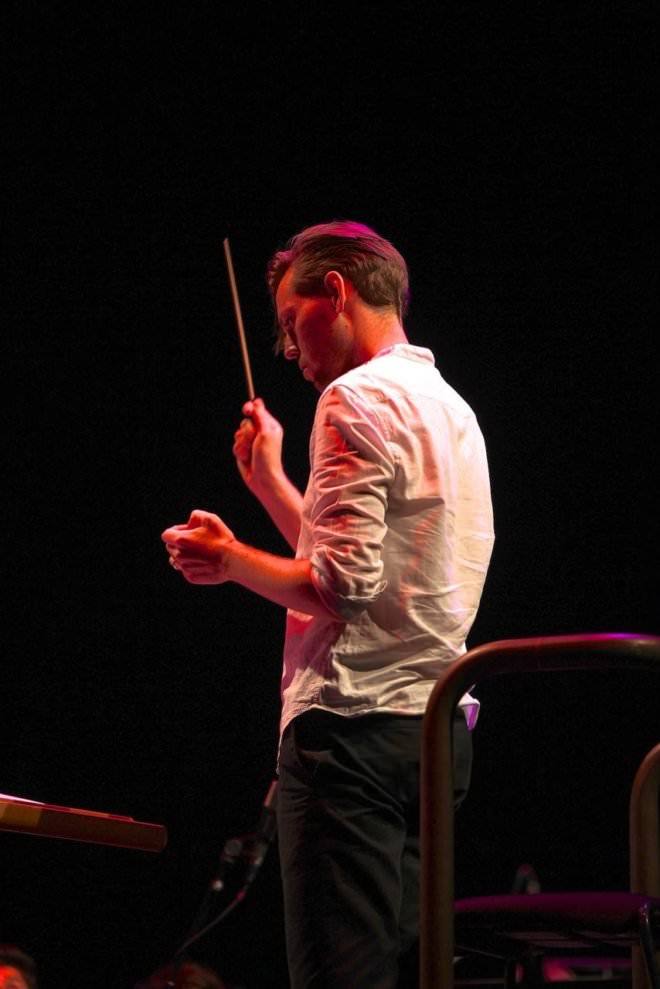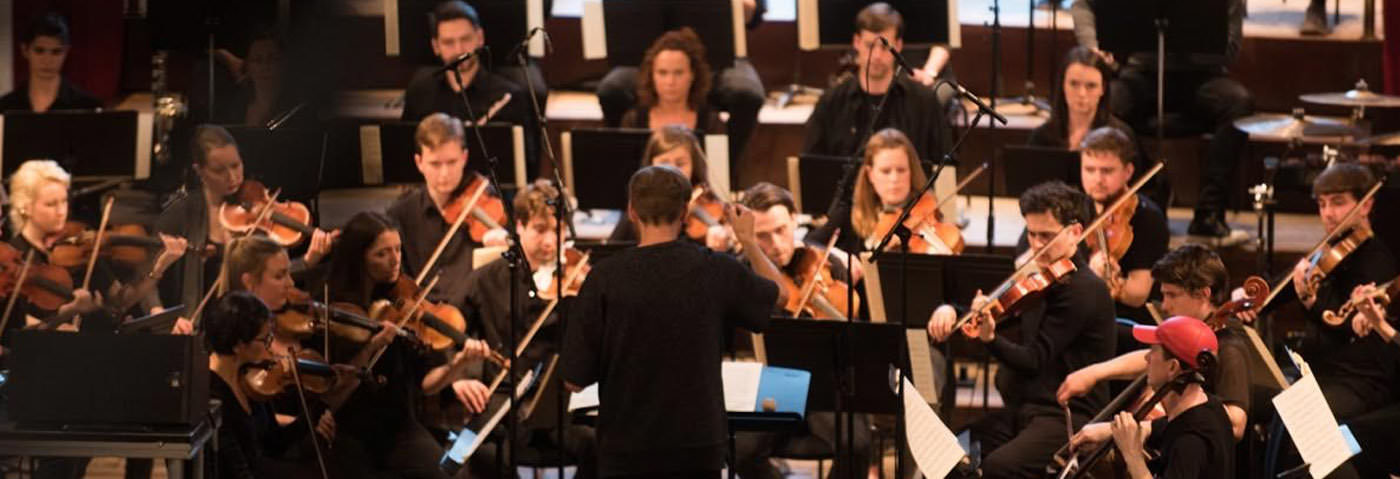The London Contemporary Orchestra conductor discusses working with Actress and Justice, fusing classical music with dance and why conductors might possess a streak of megalomania.
You may not recognise his name, but if you’ve listened to some of the biggest-selling albums of the last few years you’ve already heard Robert Ames’s work. In 2016 alone, the 31-year-old conductor was responsible for contributing strings and orchestral parts to projects including Justice’s Woman, Frank Ocean’s Endless
and Blonde and Radiohead‘s A Moon Shaped Pool.
With a background in classical music, Ames might not seem the obvious candidate to discuss electronic music, but his work revolves around the intersection of the two. In 2008, he co-founded the London Contemporary Orchestra with fellow conductor Hugh Brunt. Since then, the pair have worked to redefine the way we consider orchestral music, collaborating with artists and composers from Actress to Terry Riley along the way.
We spoke to Robert about the parallels between conducting and electronic production, the sometimes uneasy relationship between dance music and orchestras, and the experience of working with Justice.
Attack: How did you get into conducting?
Robert Ames: I started music at a pretty young age, like a lot of people do in this country – you just pick up an instrument at school. I was conducting from a fairly young age as well, which is probably less normal – I think I was conducting when I was 13 years old. I went to the Royal Academy of Music, where I did the whole music college thing, and then I started the LCO off in 2008 with my co-director Hugh Brunt.
For those who don’t know, what is the LCO?
The London Contemporary Orchestra. We’re an orchestra, but more a collective of musicians who put on gigs in London, primarily of new music, and we’re really privileged to get to do some exciting collaborations, recordings and film work, and to play in some great venues. This year we worked with Justice on their album Woman, with Radiohead on A Moon Shaped Pool and with Frank Ocean on Endless
and Blonde.
 Those are all huge projects. How did they come about?
Those are all huge projects. How did they come about?
With the Radiohead album, it was from working with Jonny Greenwood for a couple of years. We actually worked with him on the score for the Paul Thomas Anderson film The Master
, then started gigging with him a bit. We put together a show with him playing guitar and ondes Martenot with a load of string players from the LCO, doing a combination of his music and some really old Baroque music as well, like Purcell and people like that. The Radiohead recording came out of that.
Justice was a completely different connection, a singer-songwriter called Mara Carlyle who had us on her album and we’ve been working with her for a bit since. She got us in to do the strings and take care of the choir parts.
Where do you record?
A Moon Shaped Pool was at RAK Studio. The Frank Ocean tracks we recorded at Abbey Road, so London again, and Justice was at RAK.
It’s a real privilege to be able to work with artists with a big enough budget to record at places like Abbey Road and RAK.
Yeah, they’re beautiful rooms with people working in them who are amazing at what they do, which makes for a really pleasant process.
What was involved in the Justice sessions?
They were interesting from a strings point of view because the guys really knew what they wanted. They were very keen to get those super-tight disco string sounds, and on the album you can hear that the strings are a super-tight sounding group, most of the time playing in octaves or all playing a melody line without any harmonies. We spent a lot of time trying to get that right, trying to find that slightly nostalgic string disco sound. It was tough actually, getting that right – it sounds kind of simple but there’s a real clarity to that sound which was hard work to achieve.
I’m assuming they attended the recording?
Yeah, they were very much part of the process. That’s an example of one of the sessions where I did have things to say but it was really more about getting the thoughts they had out to the musicians, because they felt really strongly about how it should sound and you can hear it in their music. They were treating their strings with the precision and the transparency of all the sounds in their tracks – they wanted to get that accuracy they’d get when they’re playing electronic instruments, but from acoustic instruments, which was a really fun challenge to get right.
A lot of the time orchestral music and dance music are quite uneasy bedfellows. Dance music, pop music and rock music in general really. People often tag an orchestra onto a rock band or use it pretty much just as a focal point for a live performance and it doesn’t really work. I’m interested to know what you think makes the combination actually work well musically rather than just being a gimmick?
It’s an interesting question generally, but an interesting programming question specifically as well. I think the combination of DJs and electronic producers with orchestras can go either way: it can be the most cheesy, awful and unnatural thing, or it can be something really special. I think we’re at a really interesting point now with how music is and how people’s tastes are: our audience listens to such a diverse amount of music, and there are some really interesting electronic artists [who are] natural points where that crossover happens. We did a show at The Barbican with Actress recently and we worked with him from the ground up to write new material. That worked really well because his music always sounds a bit orchestral and has so many interesting colours in it, so much depth to it and so much texture in it already. For me that’s very different from orchestrating a 90s banger, if you know what I mean. It’s a very different world.
That’s always the worst approach, I think. There’s always been that trend of doing quick arrangements of popular songs for strings or whatever. It just never seems to add much.
Yeah, it doesn’t work, but I think there are some really meaningful collaborations that have happened and can still happen, which make for really great results.
I guess there are a lot of orchestral performers who’ve grown up with electronic music as a big part of their life. You’ve got a whole generation of musicians who’ve known electronic sounds since birth.
Yeah. With the LCO group, a lot of our musicians are kind of mid-to-late-20s, so a lot of the stuff we’re working on is music they listen to themselves. They’ve grown up being Radiohead fans, they know who Frank Ocean is and they probably like Justice’s first album – it’s probably what they were out getting drunk to when they were 18-year-olds, you know? They’re the right age for that, so we’ve already got an understanding and a feel for the music, which is a great head start.
I think classical musicians now, the younger generation seem to do more than one thing, they’re not just straight-up instrumentalists any more. A lot of my guys produce their own shows, or produce their own music, or compose music, or improvise, or work with people from different genres already, so its quite a nice space to be in.
For sure. On a personal level, you said you got into conducting at 13. That must be quite unusual. What was it that excited you about doing that at such a young age?
When I was that young? I don’t know! Maybe it was being a teenage megalomaniac…
what really excited me about conducting was probably the same thing that composers get really excited about. I’ve never composed my own music, but with a symphony orchestra you have an insane palette of colours to work with
Is there a bit of that to the conductor’s mentality in general? Are you a bit of a control freak?
I think there’s a bit of that. It’s interesting where conducting is right now: the musicians are so good that it’s become much less about the big character standing in front of a big group of musicians, dictating how something sounds. It’s much more of a facilitating process actually, where you’re getting the opinion of lots of the musicians in front of you and trying to facilitate a way to get the best out of everybody – that’s what it is for me. I think when I was young, what really excited me about it was probably the same thing that composers get really excited about. I’ve never composed my own music, but with a symphony orchestra you have an insane palette of colours to work with, and so many variables. With a piece of music there are so many possibilities for what you can do with that number of people and those instruments, I think that’s probably what excited me about it.
That palette of sounds is a really good comparison with the palette of electronic sounds a producer works with.
It really excites me at the moment actually. What LCO does a lot of the time is take electronic sounds and work out ways of getting them to work on acoustic instruments, which is a really interesting thing to do. It’s been an obsession in electronic synthesis to try and emulate string sounds, but it’s got to the stage for us where it’s more interesting to flip that and try to use acoustic instruments to emulate sounds that have been produced electronically.
Conducting is even more abstract than producing electronic tracks. We have to say something, or show something with our hands, which is being translated by another human being
I think you can compare conducting to electronic music production and engineering too. Both bring a human element into parts of the music creation process that some might dismiss as being defined by other things. In the case of electronic music production, people might say it’s defined by the equipment, and in the case of conducting, people might say it’s defined by the musicians in the orchestra. What does a conductor bring to the process?
Conducting is this mad thing in music because you’re not actually making any sound and you don’t have a voice. You’re sort of leading rehearsals, and facilitating the music and how something should sound, but you’re not doing anything concrete. It is quite abstract, and I’d say it’s even more abstract than producing electronic tracks because you can press a button on a computer to change how something sounds, but we have to say something, or show something with our hands, which is being translated by another human being who tries to do that musically with his or her instrument. It is a strange thing. I think the role of it has changed now. A conductor isn’t dictating the big picture from beginning to end any more, but trying to find a way to create something beautiful with the people in the room at the time.
It’s almost like you’re playing the humans instead of the instruments?
Yeah, I think that’s fair to say. That’s a nice analogy.
